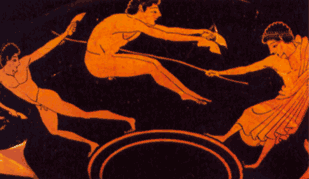The Olympic Games were a series of athleticcompetitions among representatives of city-states and one of the Panhellenic Games of Ancient Greece. They were held in honor of Zeus, and the Greeks gave them a mythological origin. The ancient Olympics had fewer events than the modern games, and only freeborn Greek men were allowed to participate. The games were held to be one of the two central rituals in Ancient Greece, the other being the much older religious festival, the Eleusinian Mysteries. The games started in Olympia, Greece, in a sanctuary site for the Greek deities near the towns of Elis and Pisa.
Some of the games that were played:
- Foot Race: When this race was ran once across the field it was called a Stade. The race was called a diaulos when running once across the field and then back to the starting point. Another race was called a Hippicos when the runners ran four Stades in a row. Some of the most famous athlets were: Leonidas of Rhodos and Orsippuss of Megara
- Chariot Race: Chariot racing was one of the most popular ancient Greek, Roman, and Byzantine sports. Chariot racing often was dangerous to both driver and horse as they frequently suffered serious injury and even death, but generated strong spectator enthusiasm. Chariot races could be watched by women, while women were barred from watching many other sports. It was possible for the winner to be a woman in official games from early on. This was likely because she was not physically competing, she was just the owner of the chariot. Women, like many athletes of their time, typically came from well known and wealthy families. Some of the most famous athletes were:Cynisca of Sparta, Nero and Tiberius
- Discus Throw: Throwing the discus was one of the five events of the pentathlon. The discus was made of stone, later of bronze, lead or iron. Excavated examples have a diameter of 17 to 35 cm and a weight of 1,3 to 6,6 kg. On average they weighed 2,5 kg, this is 0,5 kg above the minimum weight of a modern discus. The thrower had restriction on his method of throwing, and could only throw directly in front of himself. The thrower, like most athletes, had to practice his positioning and was required to position his body in order to properly throw the discos.
- Jumping: The long jump was not practiced as a separate event, but was part of the pentathlon. The jumper landed, just as today, in a sandpit. It was created by raking the hard sand of the stadion over a length of a bit more than fifteen meters. A major difference with the long jump today is that the Greeks held jumping weights or “halters” of 1,5 to 2 kg in each hand. Thanks to these halters the athletes jumped further and landed more steadily. The athlete would wear weights to toss his body forward. These were leather bands tied to their arms with weights attached to them. The jumper was required to land with both feet close together and could not land on all fours.
- Running with Armor: Consisted of men running in some pieces of armor. These were typically a helmet or shield, not too much or the runner would be weighed down. This event can be seen as an indication to the games being connected to war. The hoplitodromos or hoplitodromia was an ancient foot race, part of the Olympic Games and the other Panhellinic Games. It was the last foot race to be added to the Olympics, first appearing at the 65th Olympics in 520 BC, and was traditionally the last foot race to be held. Athletic festivals under the name of «Olympic games», named in imitation of the original festival at Olympia, were established over time in various places all over the Greek world. Some of these are only known to us by inscriptions and coins; but others, as the Olympic festival at Antioch, obtained great celebrity. After these Olympic festivals had been established in several places, the great Olympic festival itself was sometimes designated in inscriptions by the addition of Pisa.
Anagnostou Anastasios
Xanthopoulos Stratos
Goudouvas Athanasios


